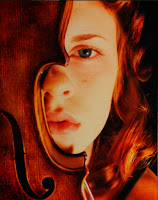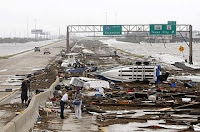2. A blog is like a journal/diary that is able to be seen in public on the internet. We use blogging in this class to write things we know, learn, and want to show others. It's a good way to publicly to show information you'd like to share.
3-4. You need a oatmeal can, photo paper, thin piece of aluminum, tape, xacto knife, needle, and sand paper. The pinhole is like the lens of the camera. Poke a tiny hole in the aluminum with a needle and trim the aluminum so there is a little space around the hole. The oatmeal can must be light proof. When the lid is on and the shutter is closed the inside has to be completely dark. The only light that comes in is through the pinhole. Make sure there are no holes or openings in the box. Seal it and paint it flat black. Cut a small square opening in the can for the pinhole to go in. Tape the pinhole behind the square opening. Center the pinhole in the square. Then make the shutter, which is just a flap that covers the pinhole from the outside and can be made with more tape. This must be done in complete darkness. Tape a piece of photo paper to the inside of the box across from the hole. Put the lid on and make sure the shutter is closed. Now you can go out in the light.Point the camera at what you want to shoot. Hold shutter open for 30 seconds, then close. Everything has to stay perfectly still. Go back to the dark room and take paper out to develop.
5. a. Rule of thirds: Image is divided into 9 equal segments by 2 vertical and 2 horizontal lines.
b. Balancing elements: Subject of the picture is off from the center, but should be balanced by putting some "weight" on the opposite side to even it out.
c. Leading lines: Straight, diagonal, zigzag, curvy lines that draw our eyes "into" the picture and enhances the photographs composition.
d. Symmetry and patterns: Can be like repeated objects in the picture, along the same way or scattered around, sometimes made intentionally or also by accident but still looks good.
e. Viewpoint: Photographing from different angles such as from above, the ground, side, back, from a long way away, from very close up, and so on.
f. Background: Trying to use a plain and unobtrusive background and compose your shot so that it doesn't distract or detract from the subject.
g. Depth: You can create depth in a photo by including objects in the front, middle and back, and also by overlapping, where you partially obscure one object with another.
h. Framing: Objects that make natural frames, such as trees, archways and holes by placing these around the edge of the composition, it helps to isolate the main subject from the rest of the shot. The result is a more focused image that draws your eye naturally to the main point of the subject.
i. Cropping:
Eliminating the background 'distractions', ensuring the subject gets the viewer's undistracted attention.
j. Mergers and avoiding them: taking photographs and trying to avoid a "distracting" background that looses the subjects' main focus.
6. Action and emotion impact a photograph by giving it a more "live" sensation when you see it. If you see a picture of a band performing, the feelings will most likely be excitement and nervousness. You might also sense as if the people are moving around, playing they're instruments.
7. A photo can "tell a story" all depending on what's taking place in the picture. The subject and details can kind of give off what the he/she wants the viewer to notice.
8. Multimedia is the integration of multiple forms of media ex. a presentation involving audio and video clips.
9. First sentence includes major information about the photo (who, what, where, when, why, how). First sentence should be written in present tense as if the action of the photo is still happening. Second sentence should be past tense, and should include background information. Information in caption should not be obvious by looking at the photo.If there are 3 or fewer recognizable people in the photo, you must give all of their names.Use strong action verbs whenever possible.
10. To know whats going on in the picture, like what's happening.
11. Fashion photography is different becasue they change the picture taken unlike photography; you take the picture and make sure its going to be the picture for what its going to be.
12. Portrait is of another person and self portrait is a picture of yourself.
13. A good portrait should be in focus, have good exposure, and uses the composition rules.
14. Newspaper is when photographers are expected to write, but if they attend multiple photography assignments the writing can be limited. Yearbook is responsible for all the content on their spread, including taking pictures, writing captions, headlines and some years writing a short story.
1. Aperture- Also called aperture stop. Optics an opening, usually circular, that limits the quantity of light that can enter an optical instrument.
2. Shutter- A mecanical device for opening and closing the aperture of a camera lens to expose film orlike.
3. Exposure- The total amount of light received by a photosensitive surface or an area of such a surface, expressed as the product of the degree of illumination and the period of illumination.
4. F-stop- The setting of an adjustable lens aperture, as indicated by an f number.
5. Single lens reflex-that typically uses a semi-automatic moving mirror system that permits the photographer to see exactly what will be captured6. Negative-whiteover black
7. Positive-black over white
8. Contact sheet-photographic image produced from flim
9. Agitation-Gentle movement of liquid photo-processing chemicals (developer, stop-bath, fixer) during processing of film or paper in order to achieve uniform results.
10. Enlarger-is a specialized transparency projector used to produce photographic prints
11. Stop bath-is a chemical bath usually used in processing traditional black-and-white photographic flims,
12. Fixer-a chemical that removes unexposed silver salts from photographic media and renders them insensitive to light.
13.Safe light: is a light source suitable for use in a photographic darkroom.
14.Burning- Increases the exposure to areas of the print that should be darker.
15.Dodging- Blocking a portion of the light when printing a photograph or manipulating a digital image so that an area of the image will be made lighter. 










































